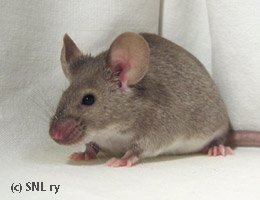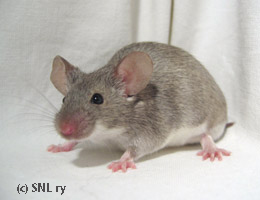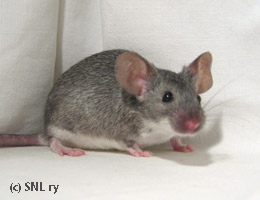Genetics
A-locus
3. Aw - White-Bellied Agouti
Aw is dominant over agouti A and all of the lower case a-locus genes, but recessive to lethal and yellow dominants.
Mice with this gene have typical agouti back, with white or cream belly. The genetic background of an AW mouse determines, whether the belly is pure white, is cream, or cream with black base of hair. This means that it is possible to selectively breed Aw mice to have a comptelety white or a good tan belly.
This gene is present in some lines of chinchilla and argente creme, thus creating the white belly present in these varieties.
Aw is a gene enabling one to get fox mice of the agouti colours; agouti fox, Cinnamon fox etc. However, these colours are not usually standardized. Furthermore, as the effects of the gene on the belly colour is variable, selective breeding will be needed to get proper agouti-based foxes, instead of ones with creamy belly.
3.1. Homozygous Forms
Aw/Aw mice are like your ordinary everyday agouti on top, but have the above-mentioned white, cream or tan belly. The absence or presence of dilutions (chocolate, blue, pink-eyed...) determine whether the colouring is full or diluted.
3.1.1. Aw/Aw; "Agouti Fox"
An Aw/* mouse can look like a good agouti tan, with the right background (read: modifiers). Without knowledge on the mouse's background and/or breeding tests, it can be impossible to say whether a mouse is an Aw/* or an A/at agouti tan.
3.1.2. Aw/Aw; "Agouti Fox"

Red Aw/Aw B/* C/* D/* P/* |

Light (c-locus dilute) Aw/Aw B/* ci/cch D/* P/* |

Aw/Aw bc/* C/* D/* P/* |

Aw/Aw bc/* cch/cch |

Chinchilla |
Agouti foxes tend to be unstandardized. Their genotype would be Aw/* B/* C/* D/* P/*.
The main difficulty with an agouti fox would be balancing the top and belly colours, with the demands of the intensity and depth of pigment, especially yellow pigment, running contrary to each other. One would have to try to keep the top colour as close to that of an agouti, but still try to get the belly colour as white as possible.
Breeding stock available to one determined to try this variety would generally be the chinchilla, which is definitely not bred to have the rich golden brown pigment "under the effect of the chinchilla gene" (this would make the chinchilla too brownish). Crossing an AW/* chinchilla with an agouti would give AW/A C/cch agouti "foxes" in the first generation. The reports from people who have done these crosses and have had these mice, have quite often described the resulting agouti foxes as - ugly.
3.1.3. Aw/Aw cch/cch, Chinchilla
Some lines of chinchilla mice are genetically Aw/Aw, Aw/at or Aw/* [..] cch/cch instead of the more common genotype of A/at [..] cch/cch. Breeding from these mice as if they were A/at [..] cch/cch can give a breeder interesting results, like agouti foxes. Trying to get self based fox colours such as black fox, can be rather difficult, if the chinchillas used are Aw mice.
For breeding chinchilla, Aw is quite a useful gene. There's much less work involved in getting the belly colour right, as even when the belly colour isn't completely white, Aw/* mice never have as deep red a belly as A/at mice. So, the diluting effect of the chinchilla dilution in homozyous form turns even a cream belly of Aw/* to white. With the top colour being like normal agouti, the end result can be quite stunning chinchilla.
Furthermore, with Aw/Aw cch/cch, one can have chinchillas that actually breed true - something the A/at cch/cch chinchillas never do (they will be giving chinchilla, grey agouti and black fox.
3.2. Heterozygous Forms
As non-chinchillated Aw varieties aren't really standardarized, I will be discussing only the chinchillated versions here...
3.2.1. Aw/A, Aw/at, Aw/a, Aw/ae
Being fully dominant over all lower a-locus genes, it does not make a difference in the mouse's phenotype whether Aw is paired with A, at, a or ae. Even with Aw heterozygous with the black-and-tan at, the mice look like regular agouti tan (or have a tad poorer belly - possibly, but not necessarily).
3.2.2. Aw/A cch/cch; Chinchilla
White-bellied agouti based chinchillas heterozygous with agouti A would not, in the manner of all heterozygous forms, breed true. Bred together, two of these would throw both chinchilla and grey agouti. If one's chinchillas never have black fox young, but do throw grey agouti, they are of the Aw/A cch/cch type.
3.2.3. Aw/at cch/cch; Chinchilla
Bred together, two white-bellied agouti based chinchillas heterozygous with black-and-tan at would throw chinchilla and black fox, but not grey agouti.
3.2.4. Aw/a cch/cch; Chinchilla
Two of these bred together, would throw chinchilla and chinchillated black - "sepia".
